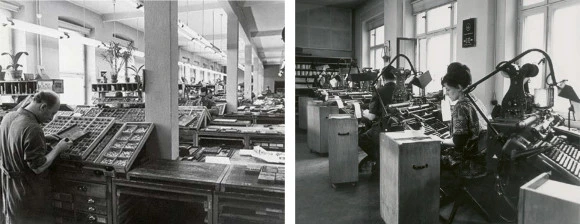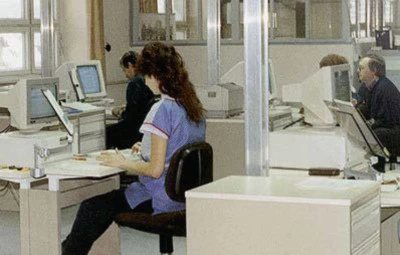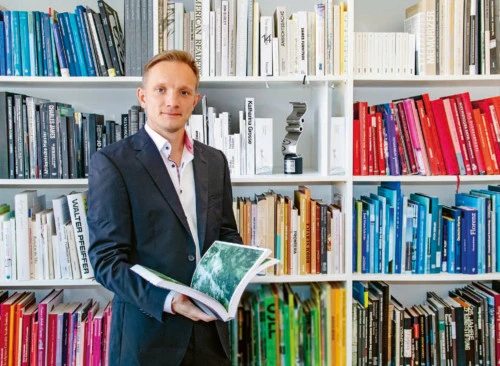Printing art WITH passion since 1594 ...
The Altenburg Printing Company has been in existence for 430 years. Here is a brief overview of our history:
1594
Founding of the Fürstlich Sächsische Officin by Duke Friedrich Wilhelm I of Saxony. The original printing house was located at Hartenfels Castle near Torgau. The first known printing by the Fürstliche Druckerey was the Torgau Catechism, published in 1594/95.

1604–1664
„The Prince of Saxony Print Shop“ moved from Weimar to Altenburg. The first print produced by the „The Prince of Saxony Court Printing Office“ was Lotio pedum in 1606. One of its most significant works was created from 1661 to 1664 thanks to a commission by Duke Friedrich Wilhelm II (who died before it was completed) was the ten-volume set of Dr. Martin Luther‘s entire blessed German writings“.

1799–1871
During this time, the court printing office belonged to the Pierer family and became well-known far beyond Germany‘s borders. Johann Friedrich Pierer and his son Heinrich August Pierer were good friends with Friedrich Arnold Brockhaus.
Between 1816 and 1829, they jointly published the Conversationslexikon (Conversation Lexicon), later referred to as the Brockhaus for short, with superb attention given to the present times.

1872
The workshop merged into the Pierersche Hofbuchdruckerei Stephan Geibel & Co. in Altenburg. In the same year, the printing building still in use today was built at the intersection of Gutenbergstraße and C.-v.-Ossietzky-Straße (formerly Hohen Straße).
1849–1930
The reputation acquired both domestically and abroad as an excellent on demand and commercial printer was also achieved in the field of finer printed materials. This was aided by Hungaran-born Albin Maria Watzulik. His printed materials garnered admiration and awards at international exhibitions.
1939–1945
Not a month went by without skilled workers being called up for military service. According to the company records, it is evident that after World War II, 24 employees were listed as missing, while another 20 employees were severely disabled due to the war.

1952–1990
The VEB Druckhaus Maxim Gorki focused on publications in the fields of chemistry, mathematics, physics, and linguistics. The precise typesetting of complex formulas could only be achieved manually.
In 1959, a modern Monotype printing system was acquired from England. The former court printing office was now regarded as one of the most modern and efficient printing plants in the German Democratic Republic.
To cope with the growing demand in typesetting and printing, the production facilities underwent new construction and renovation work. Further investments were made in a Soviet typesetting machine and in the bookbinding department‘s technical equipment.

1990–1993
The competitive pressure that emerged after the reunification demanded a swift transition from hot metal typesetting to photosetting and from letterpress to offset printing.

1993
Under the revived name DZA Druckerei zu Altenburg GmbH, Simon Tafertshofer takes over the printing company.
2004–2010
Large investments are made in machinery for the bookbinding department. In the prepress stage, the transition from computer-to-film to computer-to-plate technology is implemented.
In 2007, certification according to PSO (Process Standard Offset) was awarded for the first time by the Saxon Institute for the Printing Industry.
The acquisition of two new printing presses (KBA Rapida RA 106 5 colors + coating and RA 106 8 colors with perfecting device) expanded pressroom capacity.

2017–2022
In 2017 Peer-Philipp Keller became a member of the management board. He and the board members continued to lead the company by focusing on high quality standards and implementing their visions.
In the spring of 2019, as part of the 425th anniversary celebration of DZA (founded in 1594), an official celebration was held in the Marstall of the Altenburg Residenzschloss. Among the guests was the Minister for Economic Affairs, Wolfgang Tiefensee. Additionally, an open house event was organized, giving every visitor the opportunity to peek behind the DZA door´s.
That same year, the printing company was able to use its first digital printing press.
In the summer of 2020, Simon Tafertshofer withdrew from active business operations, and Peer-Philipp Keller took over sole management of the company.
In order to continue meeting technology standards and to further enhance quality, the company invested in two large production machines for printing and bookbinding in 2021 and 2022.








